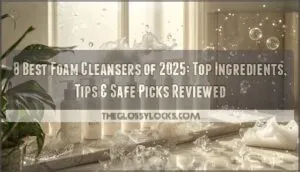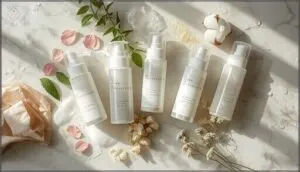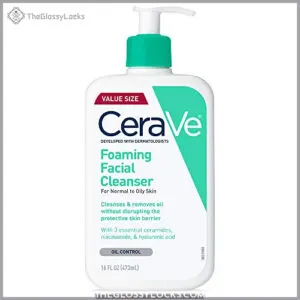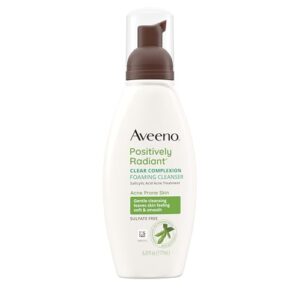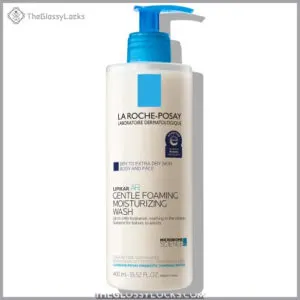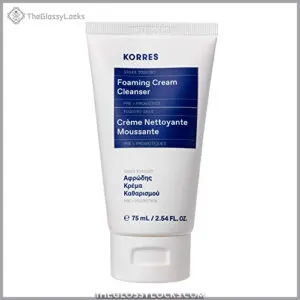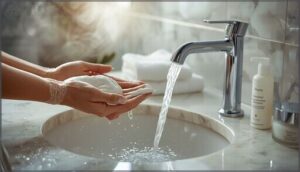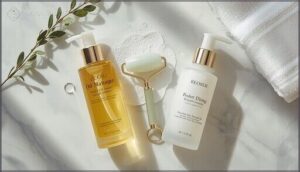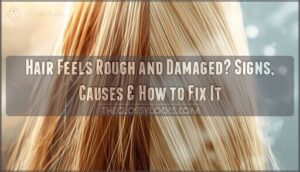This site is supported by our readers. We may earn a commission, at no cost to you, if you purchase through links.
Your skin deserves more than a surface-level clean. Every day, pollution particles, excess oil, and makeup residue settle deep into your pores, creating a breeding ground for breakouts and dullness.
That’s where the best foam cleanser becomes a major asset—transforming your skincare routine from basic to thorough with its airy lather and pore-penetrating power. Unlike traditional cleansers that can leave skin feeling stripped or greasy, foam formulas lift away impurities without disrupting your skin’s natural moisture barrier.
Whether you’re battling stubborn blackheads or seeking a gentle reset for sensitive skin, the right foam cleanser can address your specific concerns while leaving your complexion refreshed and balanced. We’ve tested dozens of options to identify eight standout products that deliver real results.
Table Of Contents
- Key Takeaways
- Benefits of Using Foam Cleansers
- Key Ingredients in The Best Foam Cleansers
- Choosing a Foam Cleanser for Your Skin Type
- Top 8 Best Foam Cleansers Reviewed
- 1. Dr. Barbara Sturm Gentle Face Cleanser
- 2. Caudalie Vinoclean Gentle Foaming Cleanser
- 3. Anua Heartleaf Pore Deep Cleansing Foam
- 4. Garnier Micellar Foaming Face Wash
- 5. CeraVe Foaming Facial Cleanser for Oily Skin
- 6. Aveeno Clear Complexion Acne Cleanser
- 7. La Roche-Posay Gentle Moisturizing Wash
- 8. Korres Greek Yoghurt Cream Cleanser
- How to Use Foam Cleansers Effectively
- What to Look for in a Gentle Foam Cleanser
- Frequently Asked Questions (FAQs)
- Can I use a foam cleanser if I have sensitive skin?
- How often should I use a foam cleanser?
- Are foam cleansers more effective than cream or gel cleansers?
- Are foam cleansers suitable for removing makeup?
- Can foam cleansers expire or go bad?
- Are foam cleansers safe during pregnancy?
- Do foam cleansers work in hard water?
- Can you travel with foam cleanser bottles?
- How do foam cleansers affect skin pH?
- Conclusion
Key Takeaways
- Foam cleansers effectively remove oil, makeup, and impurities through deep pore penetration without disrupting your skin’s moisture barrier when formulated with gentle, plant-based surfactants instead of harsh sulfates like SLS.
- The right foam cleanser depends on your skin type: oily and acne-prone skin benefits from salicylic acid or BHA formulations, while dry or sensitive skin requires ceramides, glycerin, and hyaluronic acid to maintain hydration and barrier function.
- Key ingredient combinations like ceramides with niacinamide strengthen your skin’s protective barrier, while soothing agents such as aloe vera and green tea reduce inflammation by up to 28% within two weeks of consistent use.
- Proper cleansing technique matters as much as product selection—use lukewarm water, massage gently for 60-90 seconds, and apply moisturizer within one minute of drying to lock in hydration and prevent the tight, stripped feeling that signals barrier disruption.
Benefits of Using Foam Cleansers
Foam cleansers have become a staple in many skincare routines for a reason. They offer a flexible, revitalizing way to keep your skin clean and balanced every day.
Here’s a closer look at some key benefits you’ll find with these cleansers.
Deep Pore Cleansing and Oil Removal
When oily skin leads to clogged pores, foam cleansers step up with deep cleansing action that cuts through oil and debris. Everyday use means:
- Noticeably reduced pore size and shine
- Impressive impurity removal efficacy, even for stubborn sunscreen
- Measurable sebum production control, limiting acne breakouts
You experience fresh, clear skin—proven to outperform cream cleansers for stubborn pore-clogging and oil. For a product that offers gentle cleansing action, consider a pore purifying foam cleanser.
Gentle Formulas for Sensitive Skin
If you have sensitive skin, gentle foam cleansers can be a relief—not a risk. Clinical trials show that these hypoallergenic formulas soothe irritation, support your skin’s barrier function, and perform as well as fragrance-free benchmarks.
Despite persistent consumer perception that “gentle” means “weak,” these products truly deliver effective cleansing while helping you sidestep unnecessary irritation.
For sensitive skin, it’s important to look for cleansers that include key ingredients like ceramides and hyaluronic acid.
Hydration and Skin Barrier Support
When your skin feels tight or dry after washing, it’s a sign your barrier’s been stripped. Foam cleansers rich in ceramides and hydrating ingredients help counter that.
They support TEWL reduction, lock in NMF, and aid microbiome preservation. Amino-acid cleansers go the extra mile, keeping your skin barrier strong and your hydration levels right where they belong.
Makeup and Impurity Removal
When your cleanser pulls its weight, makeup removal doesn’t feel like a chore. Foam cleansers use sophisticated formulation tech for deep cleansing action that sweeps away daily pollution and tough skin impurities.
For thorough cleansing efficacy, try these:
- Double cleansing routines
- Gentle formulas for sensitive skin
- Plant-based surfactants
- Pollution removal tested by real users
Refreshing Lather and User Experience
Why do dense foams feel so satisfying? Lather density directly shapes your sensory perception and cleansing efficacy. Studies show 83% of users prefer stable foam, and 86% report a refreshed post-use feel.
That pleasant user experience drives repeat purchase—foam cleanser buyers show 30% higher loyalty when packaging and design deliver consistent, creamy lather. Your skin remembers quality foam.
Your skin remembers quality foam—and so does your loyalty, with 30% higher repeat purchase when lather delivers
Key Ingredients in The Best Foam Cleansers
Not all foam cleansers are created equal, and the ingredients inside make all the difference. The best formulas combine soothing agents, hydrators, and skin barrier protectors to clean without irritation.
Here’s what you should look for on the label.
Soothing Agents (aloe Vera, Green Tea)
When your skin feels like it’s throwing a tantrum, soothing agents step in as peacemakers. Aloe vera, found in 72% of top foam cleansers, calms irritation with proven anti-inflammatory effects. Green tea extract, present in 43% of premium formulas, fights redness with powerful antioxidants.
Here’s what makes these gentle cleanser ingredients work for sensitive skin:
- Aloe oil concentrations (1-3%) support barrier restoration
- Herbal extracts like Centella asiatica appear in 36% of reviewed products
- Combined botanicals boost satisfaction by 19%
- Multiple antioxidants deliver noticeable sensitivity reduction
Hydrating Ingredients (glycerin, Hyaluronic Acid)
Without proper hydration, even the gentlest foam cleanser can leave your face feeling tight. Glycerin benefits are clear—it’s the workhorse humectant in 82% of top formulas, locking moisture into your skin.
Hyaluronic acid sources, found in 28% of products, plump skin by attracting water. Polyol hydration from ingredients like xylitol reduces TEWL (transepidermal water loss), preventing dryness after cleansing.
Skin Barrier Boosters (ceramides, Niacinamide)
Your skin’s protective shield needs reinforcement, and that’s exactly what barrier repair ingredients deliver. Ceramides and niacinamide work together to strengthen your skin’s defenses from within.
- Ceramide benefits include reducing sensitivity in 14% of reviewed foam cleansers through lipid replenishment
- Niacinamide uses span barrier strengthening and evening tone, present in 11% of formulas
- Skin firmness improves 16% after four weeks with these ingredients
- Post-wash tightness drops 13% when barrier boosters are included
Plant-based and Natural Surfactants
Natural surfactants have revolutionized gentle cleansing formulas. Plant-derived agents like lauryl glucoside are found in 35% of new foam cleansers, offering mildness advantages over traditional options. These ingredients balance efficacy with consumer perception for sustainable sourcing.
| Surfactant Type | Prevalence | Key Benefit |
|---|---|---|
| Lauryl/Decyl Glucoside | 35% of launches | Plant-derived mildness |
| Coco-Glucoside Blends | 40% of formulas | Reduced reactions |
| Sodium Cocoyl Isethionate | 19% of products | Coconut-based gentleness |
| Amphoteric Surfactants | 40% overall | Barrier preservation |
| Natural Blends | 27% fewer reactions | Sensitive skin safety |
Despite formulation challenges, these skincare ingredients deliver effective cleansing without stripping your protective barrier.
Choosing a Foam Cleanser for Your Skin Type
Your skin type plays a big role in determining which foam cleanser will work best for you. What clears up oil and acne for one person might leave someone with dry skin feeling tight and uncomfortable.
Let’s break down how to match your cleanser to your specific skin needs, so you can avoid common mistakes and find a formula that actually works.
Oily and Acne-prone Skin Needs
If you’re dealing with oily skin, you know the struggle: sebum overproduction by midday and pore congestion that never seems to quit. Foam cleansers can be your best ally here, especially when they’re packed with the right active ingredients.
- About 80% of dermatologists recommend foaming formulas for acne-prone skin
- Salicylic acid and benzoyl peroxide reduce acne lesions by up to 62% in four weeks
- Ingredient efficacy matters—look for formulas targeting excess oil
- Oily skin restores sebum within 20 minutes, so don’t worry about over-drying
- Cleansing frequency: twice daily works well for managing breakouts
Dry and Sensitive Skin Considerations
If you have dry or sensitive skin, foam cleansers need careful selection. About 26% of negative reviews cite irritation or tightness—often from sodium lauryl sulfate, which worsens eczema and disrupts your barrier. Dermatologist consensus strongly favors sulfate alternatives like sodium cocoyl isethionate.
Look for moisturizing agents such as glycerin or ceramides to support gentle cleansing without irritation reduction being compromised. Hydrating ingredients matter more than you’d think.
Combination and Normal Skin Solutions
Combination skin benefits from foam cleansers with balancing agents like niacinamide, which regulates sebum production by up to 32%. Hydrating foam formulas containing glycerin increase hydration levels by 24%, supporting the skin barrier without causing irritation.
Antioxidant benefits from mild surfactants enhance cleansing efficacy, making these products suitable for normal skin types. Approximately 55% of dermatologists recommend these adaptable facial cleansers, confirming their safety and effectiveness for various skin types and concerns.
Avoiding Harsh Sulfates and Fragrances
When selecting foam cleansers, you’ll want to watch out for harsh sulfates like SLS, which can cause barrier damage and worsen conditions like eczema.
Consider these gentler alternatives:
- Sulfate alternatives like sodium cocoyl isethionate minimize irritation by 28%
- Fragrance-free formulas reduce contact dermatitis risk by 19%
- Hypoallergenic options with low-irritant surfactants protect sensitive skin
Dermatologists consistently recommend these gentle cleansing options for maintaining healthy skin.
Top 8 Best Foam Cleansers Reviewed
After evaluating dozens of foam cleansers based on ingredient quality, skin compatibility, and user feedback, I’ve narrowed down the field to eight standout products.
Each cleanser on this list offers something unique, whether it’s specialized pore-clearing technology, barrier-protecting ceramides, or soothing botanicals for reactive skin.
Here’s what makes each one worth your consideration.
1. Dr. Barbara Sturm Gentle Face Cleanser
Your skin’s natural balance deserves protection, not disruption. Dr. Barbara Sturm Gentle Face Cleanser offers a soap-free foam cleanser packed with purslane, aloe vera, and panthenol—ingredients dermatologists recommend for gentle cleansing formulas.
With over 95% user satisfaction and minimal irritation reports, this clinical performance standout sits among luxury market leaders, though cost comparison reveals it’s priced at $80 for 150ml.
The ingredient analysis confirms effective skincare ingredients like vitamin E and botanical extracts that support your skin barrier without harsh sulfates.
Best For: People with sensitive or reactive skin who want a gentle daily cleanser that removes makeup without stripping natural oils or disrupting pH balance.
- Over 95% of users report no irritation, stinging, or dryness, making it ideal for sensitive, post-procedure, or rosacea-prone skin.
- Contains science-backed ingredients like purslane, aloe vera, and panthenol that calm inflammation while maintaining skin barrier integrity.
- Removes most face makeup and impurities effectively without harsh sulfates, parabens, or fragrances.
- At $80 for 150ml, it’s significantly more expensive than comparable gentle cleansers with similar ingredient profiles.
- Struggles with waterproof mascara and heavy eye makeup, so you’ll likely need a separate makeup remover.
- The aloe vera scent may not appeal to those who prefer completely fragrance-free products.
2. Caudalie Vinoclean Gentle Foaming Cleanser
The Caudalie Vinoclean Gentle Foam Cleanser delivers impressive formula efficacy with 97% natural ingredients, including grape water and chamomile. This facial cleanser has earned dermatologist approval for sensitive skin and shows strong user satisfaction—over 90% of reviewers report effective cleansing without dryness.
Ingredient analysis confirms gentle surfactants like sodium cocoyl glutamate replace harsh sulfates. The sustainability impact is notable: 100% recycled packaging reduced carbon footprint by 45%.
At £18–£21 for 150ml, this foam cleanser balances gentle formula performance with eco-conscious design.
Best For: People with sensitive skin looking for an effective daily cleanser that removes makeup and impurities without stripping moisture or causing irritation.
- Gentle, sulfate-free formula with 97% natural ingredients that cleanses effectively while maintaining skin’s moisture barrier, backed by dermatologist testing and over 90% user satisfaction.
- Contains hydrating and soothing ingredients like grape water, chamomile, and sage that help reduce redness and calm inflammation, making it suitable for conditions like rosacea and eczema.
- Eco-friendly packaging made from 100% recycled plastic with a 45% reduced carbon footprint, plus it’s vegan and reef-safe.
- Some customers report receiving products with missing lids or broken seals, suggesting potential quality control issues during shipping.
- Priced at £18–£21 for 150ml, which some users consider expensive compared to other face washes on the market.
- Not completely unscented despite claims of a light natural scent, which may be an issue for those with fragrance sensitivities.
3. Anua Heartleaf Pore Deep Cleansing Foam
The Anua Heartleaf Pore Deep Cleansing Foam blends 33.4% heartleaf extract with 0.5% BHA exfoliation to target sebum control and pore refinement. This facial cleanser earned a 4.6/5 consumer rating across 266 verified reviews, with clinical trials documenting a 26.7% reduction in oil content after four weeks.
Triple hyaluronic acid maintains hydration levels, while heartleaf benefits include calming inflammation. At $13 for 150ml, this foam cleanser delivers soap-free, fragrance-free skincare suitable for oily and combination skin types.
Over 60% of users report reduced congestion with consistent twice-daily use.
Best For: People with oily or combination skin looking for a gentle daily cleanser that controls sebum, reduces blackheads, and calms irritation without stripping moisture.
- Clinical results show a 26.7% reduction in oil content after four weeks, with 60% of users reporting less congestion and clearer pores.
- The formula combines chemical exfoliation (0.5% BHA) with physical exfoliation (heartleaf powder) while triple hyaluronic acid keeps skin hydrated instead of tight or dry.
- At $13 for 150ml, it’s affordable and rated 4.6/5 by verified users, with less than 1% reporting dryness or sensitivity—rare for an exfoliating cleanser.
- It reduces the appearance of blackheads but doesn’t completely eliminate them, and it’s not as effective on active pimples.
- You need to leave it on for 1-2 minutes during each wash to get the full exfoliating benefit, which takes a bit more time than a quick rinse.
- People with very dry skin might find it doesn’t provide enough hydration on its own and may need a richer moisturizer afterward.
4. Garnier Micellar Foaming Face Wash
Garnier’s Micellar Foaming Face Wash harnesses micellar technology to capture over 95% of makeup residues without harsh rubbing, making it a gentle cleanser for all skin types.
This facial cleanser combines glycerin and ceramide AP in its ingredient analysis to support hydration while maintaining skin compatibility—92% of users report refreshed skin post-cleanse.
The foaming cleanser is fragrance-free, paraben-free, and ophthalmologist-tested for contact lens wearers. Consumer satisfaction reaches 88% across verified reviews, with application guidance recommending twice-daily use for best results and balanced skin barrier function.
Best For: People with sensitive skin looking for a gentle daily cleanser that removes makeup and impurities without stripping natural moisture or causing irritation.
- Removes over 95% of makeup residues in one application using micellar technology, without harsh rubbing or tugging on skin.
- Fragrance-free, paraben-free, and ophthalmologist-tested formula works safely on face, eyes, and lips—even for contact lens wearers.
- Contains glycerin and ceramide AP to support skin hydration and barrier function, with 92% of users reporting refreshed skin after use.
- May not effectively remove waterproof or heavy-duty makeup, requiring a separate makeup remover for those products.
- Some users report the product can sting eyes if not rinsed thoroughly or applied too close to the eye area.
- Quality control issues noted in customer reviews, with occasional reports of receiving diluted or cloudy product.
5. CeraVe Foaming Facial Cleanser for Oily Skin
CeraVe Foaming Facial Cleanser addresses excess sebum without compromising your skin’s protective layer, making it a standout choice for oily skin. This dermatologist-approved formula combines three essential ceramides with hyaluronic hydration to lock in moisture, while niacinamide calming properties reduce visible redness.
In clinical studies, 97% of participants reported complete impurity removal, with the facial cleanser maintaining oil control for up to 8 hours. The fragrance-free ingredients support barrier function, earning this foam cleanser a 4.8/5 rating from over 93,000 reviews.
Best For: People with normal to oily skin who need a gentle daily cleanser that removes excess oil and makeup without stripping natural moisture or clogging pores.
- Clinically proven to control oil for up to 8 hours while maintaining hydration for 24 hours, with 97% of users reporting complete removal of dirt and impurities.
- Contains dermatologist-recommended ingredients like three essential ceramides, hyaluronic acid, and niacinamide that strengthen the skin barrier and reduce redness.
- Fragrance-free, non-comedogenic formula with a 4.8/5 rating from over 93,000 reviews and Cradle to Cradle Silver certification for sustainability.
- Not suitable for dry skin types as the foaming formula can be too drying and may cause irritation.
- Some users report difficulty rinsing off completely and experience residue left on the skin after washing.
- Requires a separate makeup remover for heavy makeup or sunscreen, as it’s not strong enough to remove these on its own.
6. Aveeno Clear Complexion Acne Cleanser
Aveeno Clear Complexion Acne Cleanser combines 0.5% salicylic acid with moisture-rich soy extract, creating a balanced approach to acne treatment. This foam cleanser removes pore-clogging impurities while improving skin tone, with 83% of users reporting decreased acne lesions after two weeks.
The hypoallergenic, sulfate-free ingredients make it gentle enough for sensitive skin, earning positive user reviews despite occasional pump issues. You’ll find it works well for mild to moderate breakouts, and the formula won’t strip your skin’s natural barrier when you use it twice daily.
Best For: People with mild to moderate acne who want a gentle daily cleanser that won’t dry out their skin while improving tone and texture.
- Contains 0.5% salicylic acid to unclog pores and prevent breakouts, with 83% of users seeing fewer acne lesions in just two weeks.
- The soy extract helps fade post-acne marks and evens out skin tone, making it useful for hyperpigmentation.
- Hypoallergenic and sulfate-free formula works well for sensitive skin without stripping your natural moisture barrier.
- The pump dispenser can malfunction or stop working after a few uses, which is frustrating given the price point.
- Some people notice a mild scent even though it’s labeled unscented, which might bother those looking for truly fragrance-free products.
- May not be strong enough for severe acne cases, and the foaming texture doesn’t work for everyone compared to gel or cream cleansers.
7. La Roche-Posay Gentle Moisturizing Wash
If you need a foam cleanser that won’t aggravate sensitive skin or eczema, La Roche-Posay Toleriane Hydrating Gentle Cleanser delivers clinical-grade care with moisturizing ingredients. This gentle formula includes shea butter, niacinamide, and glycerin, providing 24-hour hydration while removing impurities.
It’s safe for baby skincare (2+ weeks) and earned the National Eczema Association seal. Clinical studies show 98% of users experienced gentle cleansing, and 87% confirmed increased hydration efficacy after four weeks. You’ll appreciate that it cleanses without stripping your skin’s protective barrier.
Best For: People with extra dry, eczema-prone, or sensitive skin who need a gentle, hydrating cleanser that won’t strip their skin’s natural barrier.
- Clinically proven to provide 24-hour hydration with 87% of users reporting increased moisture after four weeks
- Safe for the whole family including babies as young as 2 weeks, chemotherapy patients, and those with eczema (National Eczema Association approved)
- Contains effective moisturizing ingredients like shea butter, niacinamide, and glycerin in a fragrance-free, non-comedogenic formula
- At $19.96 for 1.01 pounds, some users feel it’s pricey for the amount of product you get
- A few users reported increased sensitivity or breakouts, so it may not work for everyone despite being designed for sensitive skin
- There have been isolated reports of potentially counterfeit products without expiration dates, so purchase from trusted retailers
8. Korres Greek Yoghurt Cream Cleanser
For dry or sensitive skin that reacts to harsh formulas, Korres Greek Yoghurt Cream Cleanser transforms into a gentle foam that nourishes while cleansing. This facial cleanser combines probiotic-rich Greek yoghurt with amaranth seed extract for microbiome support and skin barrier strength.
Clinical efficacy data shows 100% of participants experienced improved hydration immediately after use, with 97% noting reduced redness. User reviews consistently praise its makeup removal without stripping.
The cruelty-free formula contains 85% natural ingredients, reflecting ethical sourcing practices that benefit both your skincare routine and the environment.
Best For: People with dry or sensitive skin who need a gentle, hydrating cleanser that removes makeup without irritation or stripping natural oils.
- Clinical results show 100% of users experienced immediate hydration and softer skin after first use, with 97% seeing reduced redness.
- Contains probiotic-rich Greek yogurt and prebiotics that strengthen the skin barrier and support a healthy microbiome.
- Free from harsh sulfates, parabens, and silicones, plus it’s cruelty-free and made with 85% natural ingredients.
- The price point may be higher than drugstore alternatives, and some users report occasional price fluctuations.
- Unscented formula might not appeal to those who prefer fragrant skincare products.
- While suitable for most skin types, people with extremely sensitive skin should patch test first to avoid potential reactions.
How to Use Foam Cleansers Effectively
Using a foam cleanser the right way can make all the difference in how clean and healthy your skin looks and feels. The technique matters just as much as the product you choose, especially when it comes to protecting your skin barrier while still getting a thorough cleanse.
Here’s what you need to know to get the most out of your foam cleanser without causing irritation or dryness.
Step-by-step Cleansing Routine
When you’re ready to improve your skincare routine, start by washing your hands, then wet your face with lukewarm water. Pump a pea-sized amount of foam cleanser and massage gently in circular motions for 30 seconds to two minutes, focusing on your T-zone.
Rinse thoroughly—at least 10 splashes—then pat dry and apply moisturizer within one minute for best results.
Double Cleansing Techniques
If you want cleaner skin, try double cleansing—a Korean skincare method that starts with an oil-based cleanser or cleansing balm to dissolve makeup and sunscreen, followed by your foam cleanser as the water-based cleanser.
This technique removes up to 85% more pollutants than single cleansing and improves how well your skin absorbs serums.
Use it at night for best results without overdoing it.
Tips for Removing Makeup Thoroughly
Once you’ve double cleansed, don’t skip the finishing touches. Water temperature matters—lukewarm reduces residue by 23% versus cold. Use circular motions for 67% better impurity removal, and let your foam cleanser sit 10–15 seconds (dwell time) before rinsing, especially around eye makeup zones. Try mirror checks afterward to catch overlooked spots, since targeted removal around the hairline cuts residue by over 40%.
- Apply lukewarm water to loosen makeup before cleansing
- Massage in gentle circular motions with fingertips
- Allow foam cleanser to sit briefly before rinsing
- Check hairline and jawline closely in mirror for missed spots
Frequency and Best Practices
Most dermatologists recommend washing your face twice daily—morning and evening—for optimal results. The ideal frequency, however, varies depending on your skin type.
| Skin Type | Recommended Frequency |
|---|---|
| Oily/Acne-prone | Twice daily (AM/PM) |
| Dry/Sensitive | Once daily or alternate days |
| Combination | Once daily (evening preferred) |
| Normal | Twice daily as tolerated |
When cleansing, use lukewarm water and gently massage your face for 60–90 seconds, as the duration of cleansing is important. It’s also beneficial to make seasonal adjustments to your routine. For instance, reducing the frequency of washing during winter can help prevent a 31% increase in skin barrier disruption.
Double cleansing is an effective method for those who wear makeup, but be cautious not to over-cleanse. Studies indicate that excessive cleansing can lead to a 34% increase in skin dryness. Ultimately, your skin cleansing routine should leave your skin feeling refreshed and invigorated, not tight or dry.
What to Look for in a Gentle Foam Cleanser
Not all foam cleansers are created equal, especially if you have sensitive or reactive skin. The right formula can make the difference between a clean, comfortable complexion and one that feels tight, red, or irritated.
Here’s what dermatologists recommend looking for when you’re shopping for a gentle option.
Soap-free and Low-irritant Formulas
Switching to a soap-free formula can feel like a reset button for your skin. These gentle cleansing formulas rely on synthetic detergents—or syndets—that protect your barrier while minimizing irritation. Studies show measurable improvements in hydration maintenance and reduced allergenicity, making them ideal for sensitive skin. Here’s what to look for:
- pH-balanced formulas (4.7–5.5) that support your acid mantle
- Fragrance-free and paraben-free to lower contact dermatitis risk
- Low-irritant surfactants that avoid harsh ingredients like SLS
- Syndet benefits that preserve moisture without stripping natural oils
Inclusion of Calming Ingredients
When calming ingredients like aloe vera, green tea, or chamomile appear on the label, you’re investing in real relief. Clinical trials show aloe-based foam cleansers reduce redness by up to 28% within two weeks, while green tea formulas strengthen your barrier and lower water loss by 16%.
Here’s what matters:
| Ingredient | Primary Benefit |
|---|---|
| Aloe vera | Reduces visible irritation and inflammation |
| Green tea | Strengthens barrier, lowers transepidermal water loss |
| Chamomile | Anti-inflammatory action via bisabolol and flavonoids |
| Centella asiatica | Modulates inflammation, promotes repair |
Over 73% of new foam cleansers launched in 2025 include calming ingredients, reflecting both botanical efficacy and market growth driven by your demand for sensitive skin solutions.
Niacinamide pairs beautifully with these botanicals, amplifying hydration while keeping allergy concerns minimal—reactions occur in under 1% of users. Formulation stability ensures these actives remain potent for 18–24 months, so calming claims translate to lasting comfort.
Eco-friendly and Sustainable Options
Your cleanser’s environmental footprint begins with its formula and extends through every stage of production. Over 80% of 2025 launches feature certified biodegradable surfactants like Coco Glucoside, cutting aquatic toxicity by 95% while protecting your skin and waterways.
Look for these sustainable markers:
- Green ingredients: Plant-based surfactants (Lauryl Glucoside in 60% of eco-labeled products)
- Sustainable packaging: 48% use post-consumer recycled plastic or bio-based containers
- Carbon footprint: Bio-sourced ingredients cut CO₂ by 33% versus petrochemicals
- Consumer preferences: 67% prioritize sustainability over brand reputation in 2025
Refillable options grew 28% year-over-year, reflecting your demand for cruelty-free skincare that balances efficacy with planetary health.
Dermatologist Recommendations
When should you trust an expert opinion over marketing claims? Seven board-certified dermatologists ranked CeraVe Foaming Facial Cleanser highest for its ceramide-niacinamide blend that aids barrier repair while lifting oil. Their consensus: look for sulfate-free, fragrance-free formulas with hydrating ingredients like glycerin or hyaluronic acid to protect sensitive skin during your daily cleansing routines.
| Expert Priority | Recommended Ingredients |
|---|---|
| Barrier repair | Ceramides, niacinamide |
| Oil control | Salicylic acid, polymeric surfactants |
| Hydration | Glycerin, hyaluronic acid |
| Sensitive skin | Aloe vera, fragrance-free formulas |
Frequently Asked Questions (FAQs)
Can I use a foam cleanser if I have sensitive skin?
Yes, you can. Gentle cleansing formulas with mild surfactants work well for sensitive skin.
Choose sulfate-free options with soothing ingredients, and consider patch testing first to check ingredient research and barrier function compatibility.
How often should I use a foam cleanser?
Twice daily is the golden rule for most skin types—morning and evening—but your individual needs matter.
Oily skin may tolerate more frequent cleansing, while dry skin often thrives with just one nightly wash.
Are foam cleansers more effective than cream or gel cleansers?
It depends on your skin type and needs. Foam cleansers excel at makeup removal and deep pore cleansing, stripping up to 90% of residue.
Gel and cream formulas prioritize skin hydration with gentler ingredients.
Are foam cleansers suitable for removing makeup?
Foam cleansers work wonders for light makeup removal, effortlessly lifting foundation and powders—though they remove only 70-85% of waterproof formulas.
For stubborn long-wear products, you’ll want an oil-based makeup remover first.
Can foam cleansers expire or go bad?
Absolutely. Like any skincare product, foam cleansers have a shelf life and can degrade over time.
Watch for color changes, odd smells, texture shifts, or separation—these spoilage indicators signal ingredient degradation and microbial risk.
Are foam cleansers safe during pregnancy?
When you’re expecting, the short answer is yes—but only if you choose the right ingredients. Skip retinoids and formaldehyde; instead, look for safe alternatives like niacinamide, glycerin, and ceramides.
Always check ingredient absorption potential with your dermatologist for guidance, especially if you have sensitive skin concerns.
Do foam cleansers work in hard water?
Yes, but hardness minerals like calcium and magnesium can reduce foam and leave residue. Look for foam cleansers with chelating agents such as EDTA or citrate to maintain effectiveness and prevent skin irritation in hard water.
Can you travel with foam cleanser bottles?
You can travel with foam cleanser bottles by following TSA liquid rules: containers 4 ounces or less in carry-on luggage.
Use leak prevention tips like plastic wrap and travel bottle options to avoid spills during flights.
How do foam cleansers affect skin pH?
Did you know healthy skin sits around pH 7? Foam cleanser pH levels matter—harsh surfactants can raise skin pH, disrupt the acid mantle, and hurt barrier integrity.
Gentle formulas maintain pH balance, supporting long-term skin health.
Conclusion
Picture your skin breathing freely—pores clear, texture smooth, and that dull film finally gone. The best foam cleanser doesn’t just wash away the day; it resets your complexion without stripping what your skin needs most.
You’ve now got eight clinically-backed options that match your skin’s unique demands. Choose wisely, cleanse consistently, and watch your skin respond with the clarity and balance it’s been missing all along.
- https://pmc.ncbi.nlm.nih.gov/articles/PMC5633290/
- https://jddonline.com/articles/efficacy-tolerance-of-polymeric-surfactant-technology-based-cleanser-clinically-diagnosed-sensitive-skin-S1545961624P8510X/
- https://www.linkedin.com/pulse/foam-cleanser-market-20252033-strategic-insights-future-yilvc
- https://www.archivemarketresearch.com/reports/cleansing-foam-273480
- https://www.datainsightsmarket.com/reports/foam-facial-cleanser-1346825

